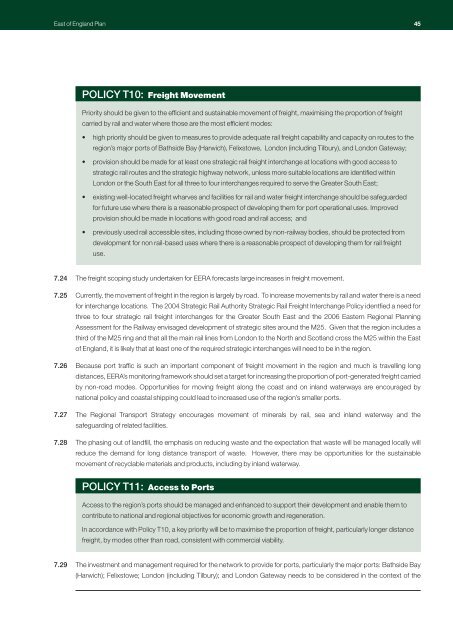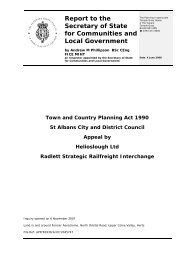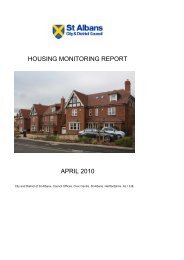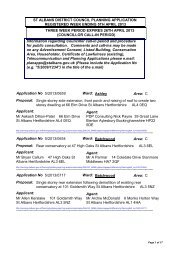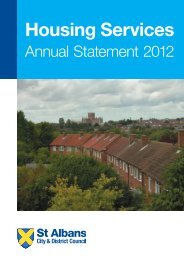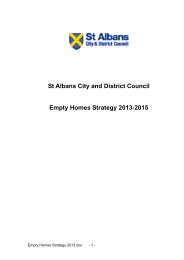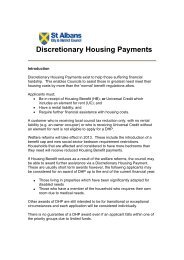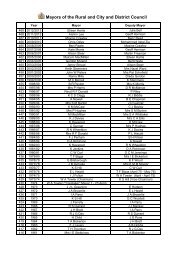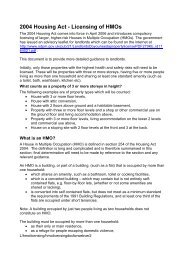RSS East Of England Plan - Broads Authority
RSS East Of England Plan - Broads Authority
RSS East Of England Plan - Broads Authority
You also want an ePaper? Increase the reach of your titles
YUMPU automatically turns print PDFs into web optimized ePapers that Google loves.
<strong>East</strong> of <strong>England</strong> <strong>Plan</strong> 45<br />
POLICY T10: Freight Movement<br />
Priority should be given to the efficient and sustainable movement of freight, maximising the proportion of freight<br />
carried by rail and water where those are the most efficient modes:<br />
• high priority should be given to measures to provide adequate rail freight capability and capacity on routes to the<br />
region’s major ports of Bathside Bay (Harwich), Felixstowe, London (including Tilbury), and London Gateway;<br />
• provision should be made for at least one strategic rail freight interchange at locations with good access to<br />
strategic rail routes and the strategic highway network, unless more suitable locations are identified within<br />
London or the South <strong>East</strong> for all three to four interchanges required to serve the Greater South <strong>East</strong>;<br />
• existing well-located freight wharves and facilities for rail and water freight interchange should be safeguarded<br />
for future use where there is a reasonable prospect of developing them for port operational uses. Improved<br />
provision should be made in locations with good road and rail access; and<br />
• previously used rail accessible sites, including those owned by non-railway bodies, should be protected from<br />
development for non rail-based uses where there is a reasonable prospect of developing them for rail freight<br />
use.<br />
7.24 The freight scoping study undertaken for EERA forecasts large increases in freight movement.<br />
7.25 Currently, the movement of freight in the region is largely by road. To increase movements by rail and water there is a need<br />
for interchange locations. The 2004 Strategic Rail <strong>Authority</strong> Strategic Rail Freight Interchange Policy identfied a need for<br />
three to four strategic rail freight interchanges for the Greater South <strong>East</strong> and the 2006 <strong>East</strong>ern Regional <strong>Plan</strong>ning<br />
Assessment for the Railway envisaged development of strategic sites around the M25. Given that the region includes a<br />
third of the M25 ring and that all the main rail lines from London to the North and Scotland cross the M25 within the <strong>East</strong><br />
of <strong>England</strong>, it is likely that at least one of the required strategic interchanges will need to be in the region.<br />
7.26 Because port traffic is such an important component of freight movement in the region and much is travelling long<br />
distances, EERA’s monitoring framework should set a target for increasing the proportion of port-generated freight carried<br />
by non-road modes. Opportunities for moving freight along the coast and on inland waterways are encouraged by<br />
national policy and coastal shipping could lead to increased use of the region’s smaller ports.<br />
7.27 The Regional Transport Strategy encourages movement of minerals by rail, sea and inland waterway and the<br />
safeguarding of related facilities.<br />
7.28 The phasing out of landfill, the emphasis on reducing waste and the expectation that waste will be managed locally will<br />
reduce the demand for long distance transport of waste. However, there may be opportunities for the sustainable<br />
movement of recyclable materials and products, including by inland waterway.<br />
POLICY T11: Access to Ports<br />
Access to the region’s ports should be managed and enhanced to support their development and enable them to<br />
contribute to national and regional objectives for economic growth and regeneration.<br />
In accordance with Policy T10, a key priority will be to maximise the proportion of freight, particularly longer distance<br />
freight, by modes other than road, consistent with commercial viability.<br />
7.29 The investment and management required for the network to provide for ports, particularly the major ports: Bathside Bay<br />
(Harwich); Felixstowe; London (including Tilbury); and London Gateway needs to be considered in the context of the


